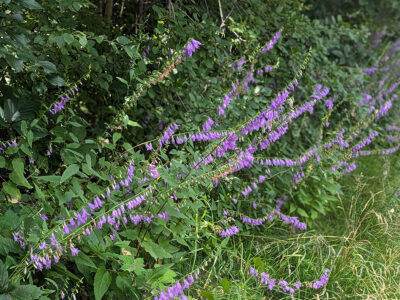Talking Plants
Jillian Patrie | University of Minnesota Yard and Garden Extension
A weed is defined as a plant growing where it is unwanted, so how do we decide if a plant is good or bad for our landscape? Overtime, many landscape plants that were once ornamental have since joined a long list of invasive or noxious weeds in Minnesota and the United States. We are familiar with the big ones like; purple loosestrife, garlic mustard, Canadian thistle, leafy spurge, buckthorn and the list goes on. Why are invasive or noxious weeds such a problem and how can we remove them from our yards and gardens?
Noxious and invasive weeds spread quickly and outcompete many of the native plant species which negatively impacts wildlife that depend on those native plants. Invasive species can impact human enjoyment of natural spaces, by destroying diversity in the landscape and impacting the use of those spaces.
There are two guidelines that the Minnesota Department of Agriculture recommends for controlling noxious or invasive plants for private property. If the plant is on an individual property; “kill but do not remove weeds from infested area” and “if removal is necessary, properly contain and transport the plant materials to a disposal site that accepts noxious weed materials”. The best method for controlling noxious or invasive weeds according to MDA is to kill and let them decay naturally on site. You can help the control of noxious weeds in your area by notifying local county soil and water districts. For more information on controlling noxious weeds visit https://www.dnr.state.mn.us/invasives/terrestrialplants/index.html
Noxious weeds are a serious problem, but what about the other weeds that we commonly see in lawns and landscapes, here are a few tips and tricks for controlling pesky weeds.
Crabgrass is an annual grassy weed that we all have in our lawns and is best controlled in the spring with a pre-emergent. Quackgrass is an aggressive perennial grassy weed that can be difficult to control in new and established lawns. Quackgrass spreads through rhizomes (like strawberries) and is generally controlled effectively with herbicide. Glyphosate is recommended for control, but also kills broadleaf and other grasses, so be mindful when using this herbicide. Dandelions are also a perennial weed that many want out of their lawns. Dandelions should be treated in the late summer or early fall, with a broadleaf weed herbicide. Creeping charlie lives up to its name and will spread into a lawn quickly. It can be hard to control with herbicide treatments and may require multiple treatments. Many perennial weeds are best treated in the fall, as they are moving nutrients down into their roots to prepare for winter.
Weedy plants have positive attributes as well, dandelions tend to be the first ones to bloom and provide food for emerging insects in the spring. Parts of dandelion can be eaten, and the flowers are commonly used to make dandelion jelly! Common purslane and wood sorrel are also edible weeds that you may find in your lawn.
For more information on controlling weeds visit https://extension.umn.edu/planting-and-growing-guides/controlling-weeds-home-gardens and for questions about this article or local horticulture assistance, contact your local Clay County Extension Educator, Jill Patrie at patri350@umn.edu or by phone at 218-299-7338.



